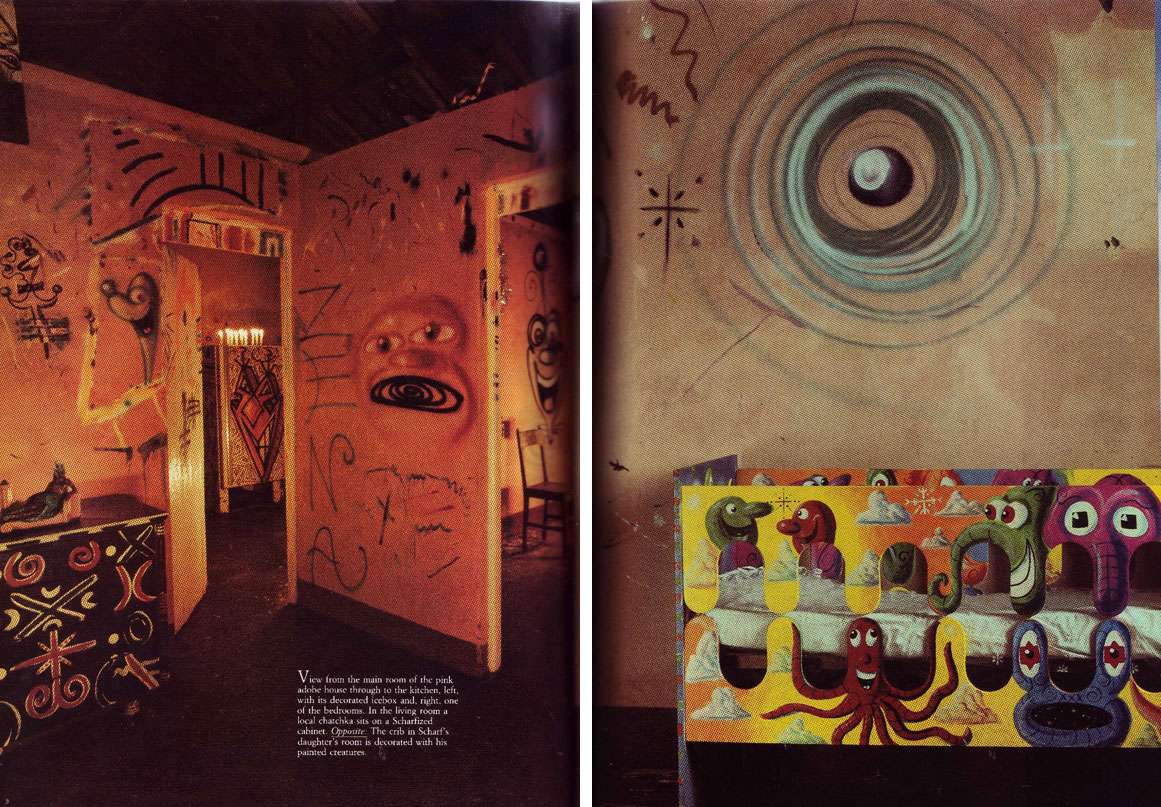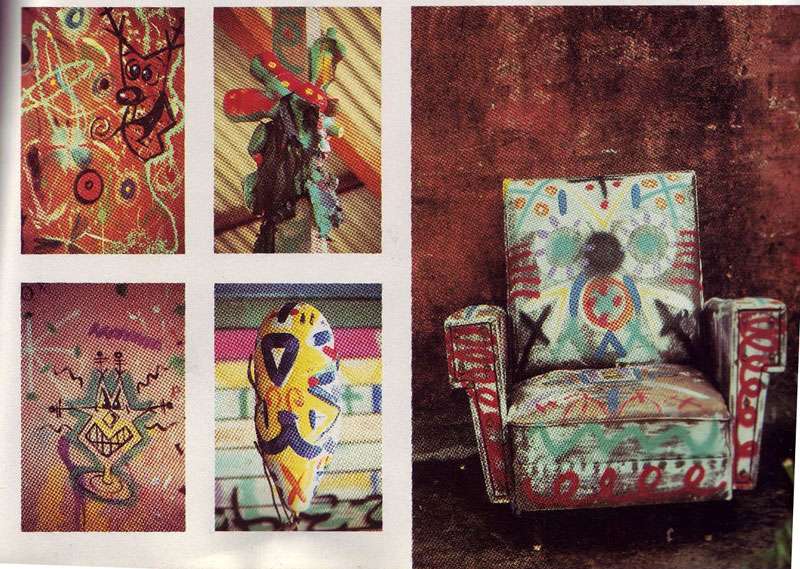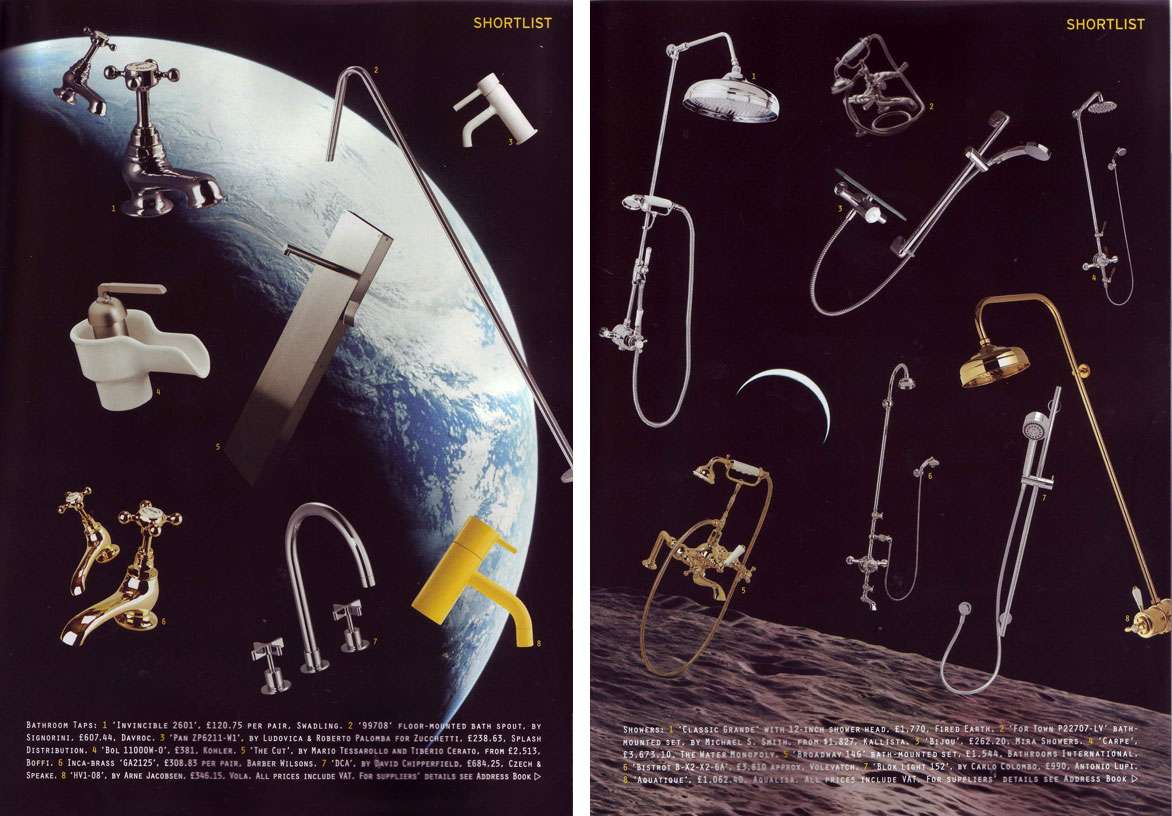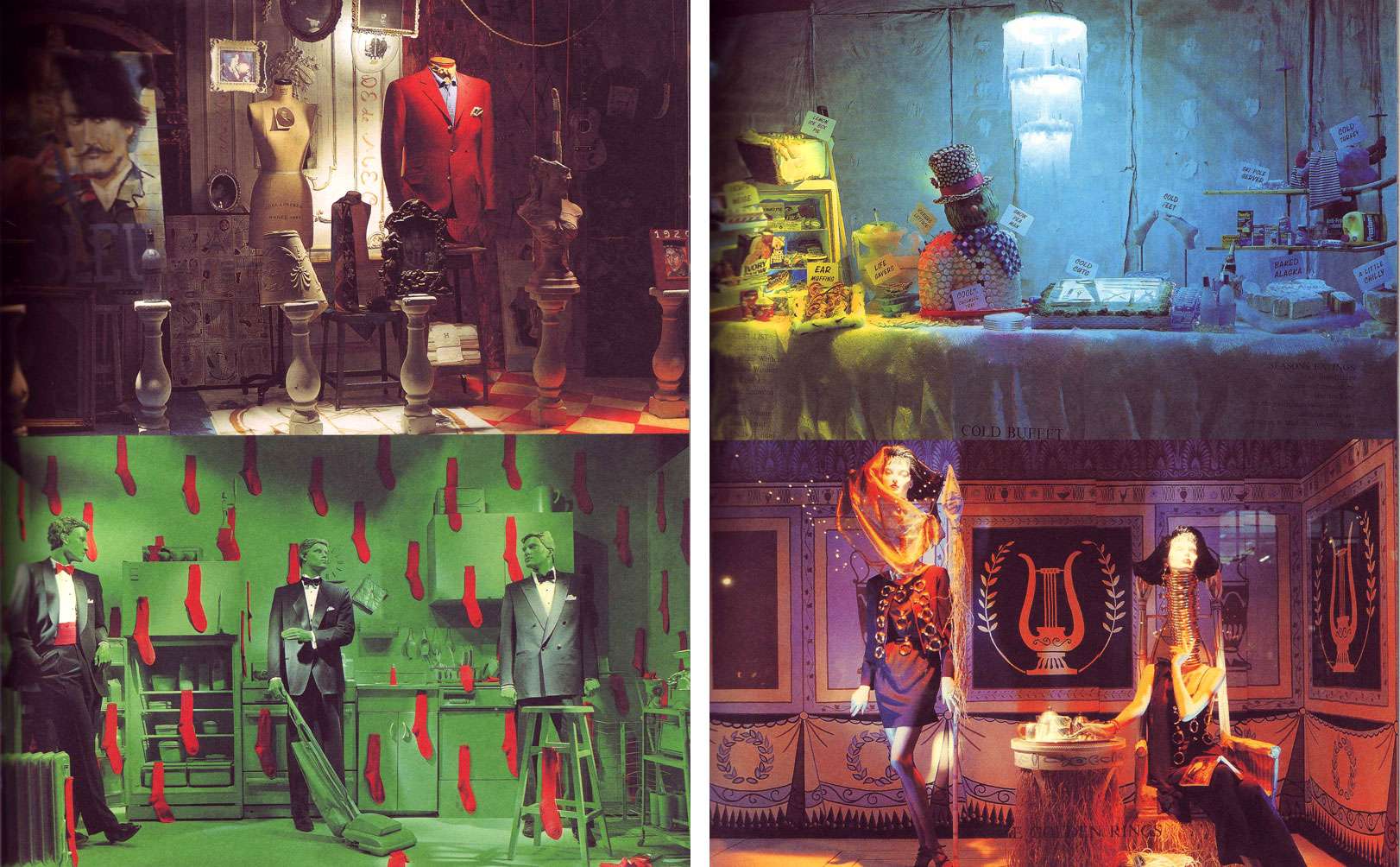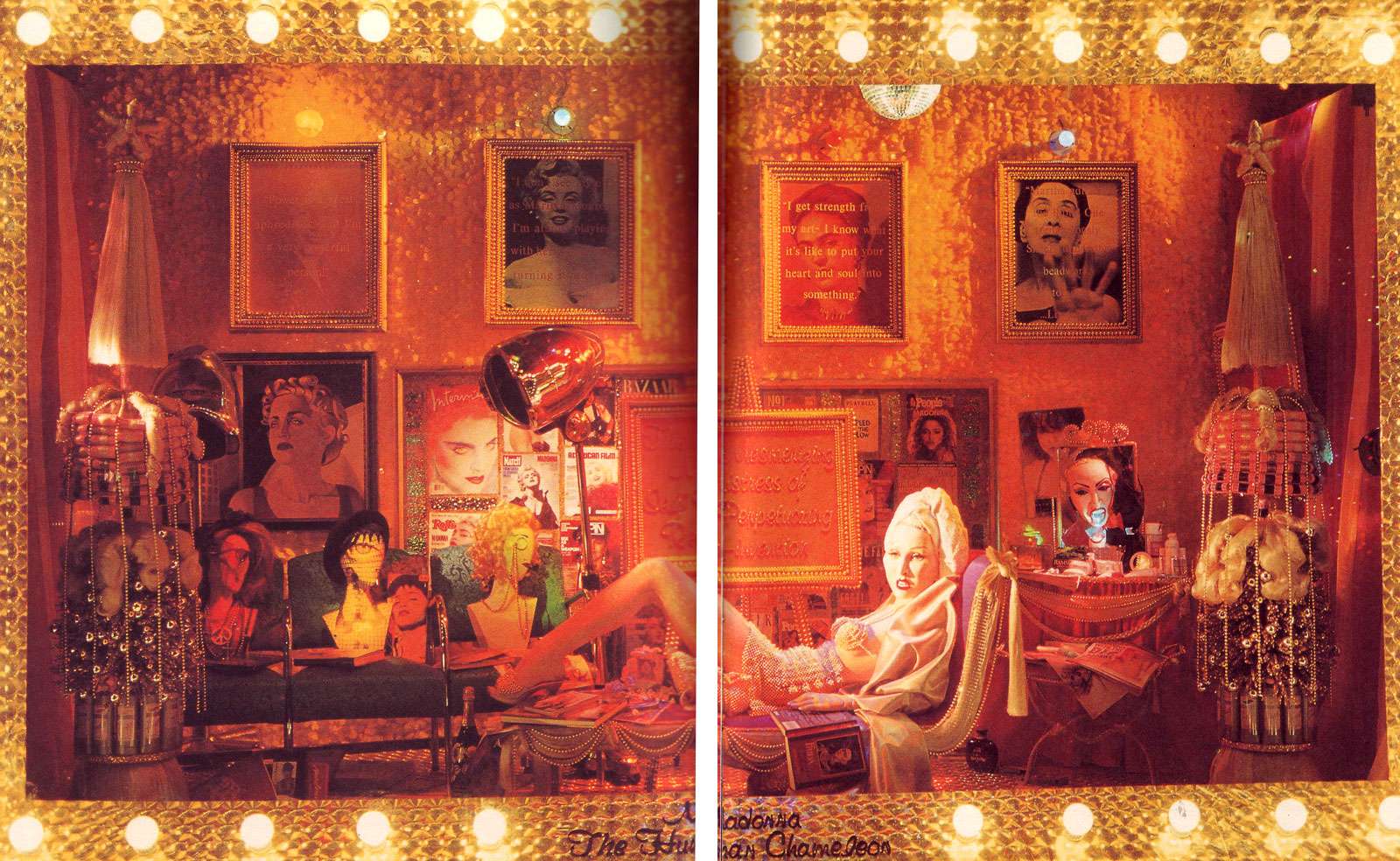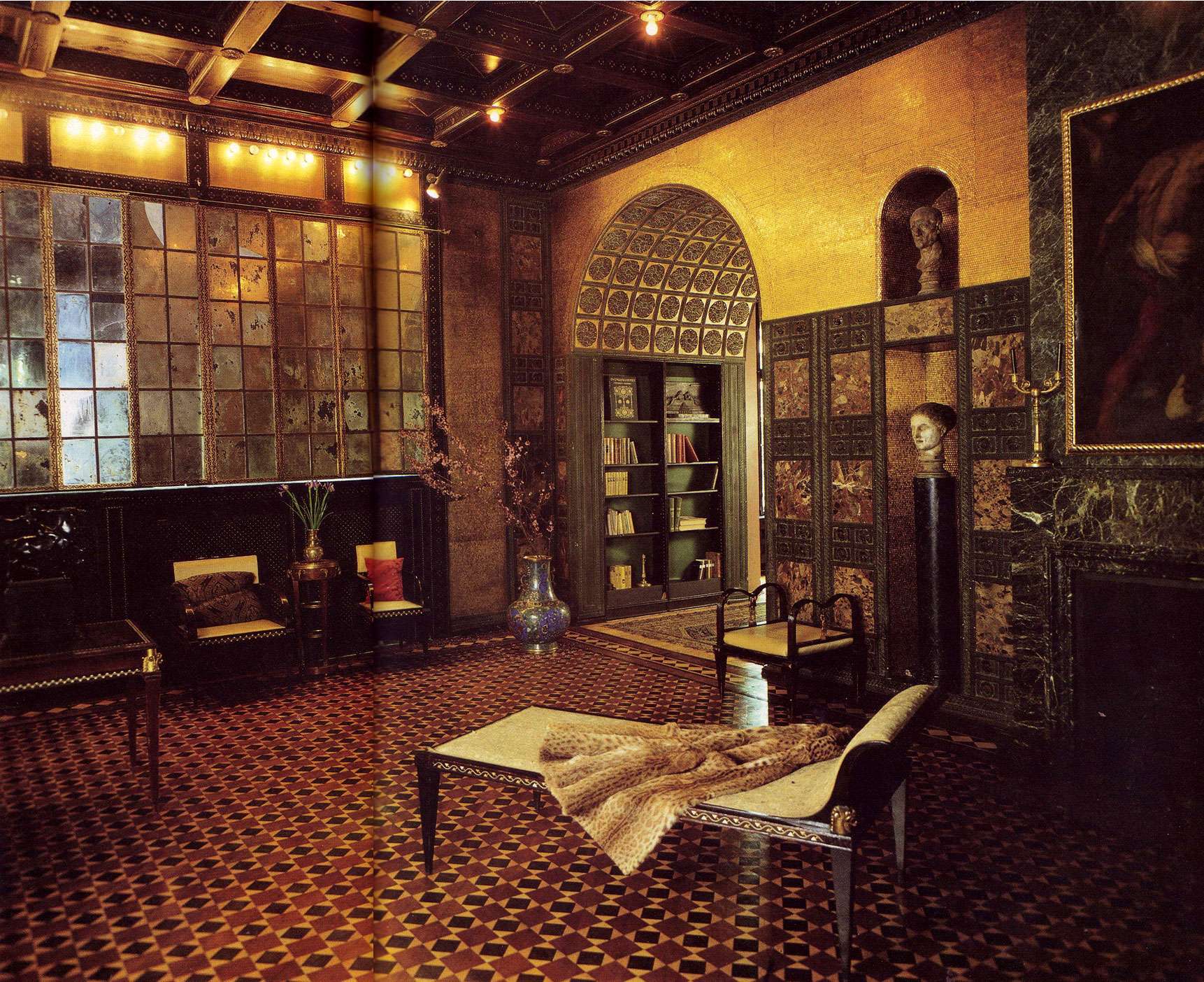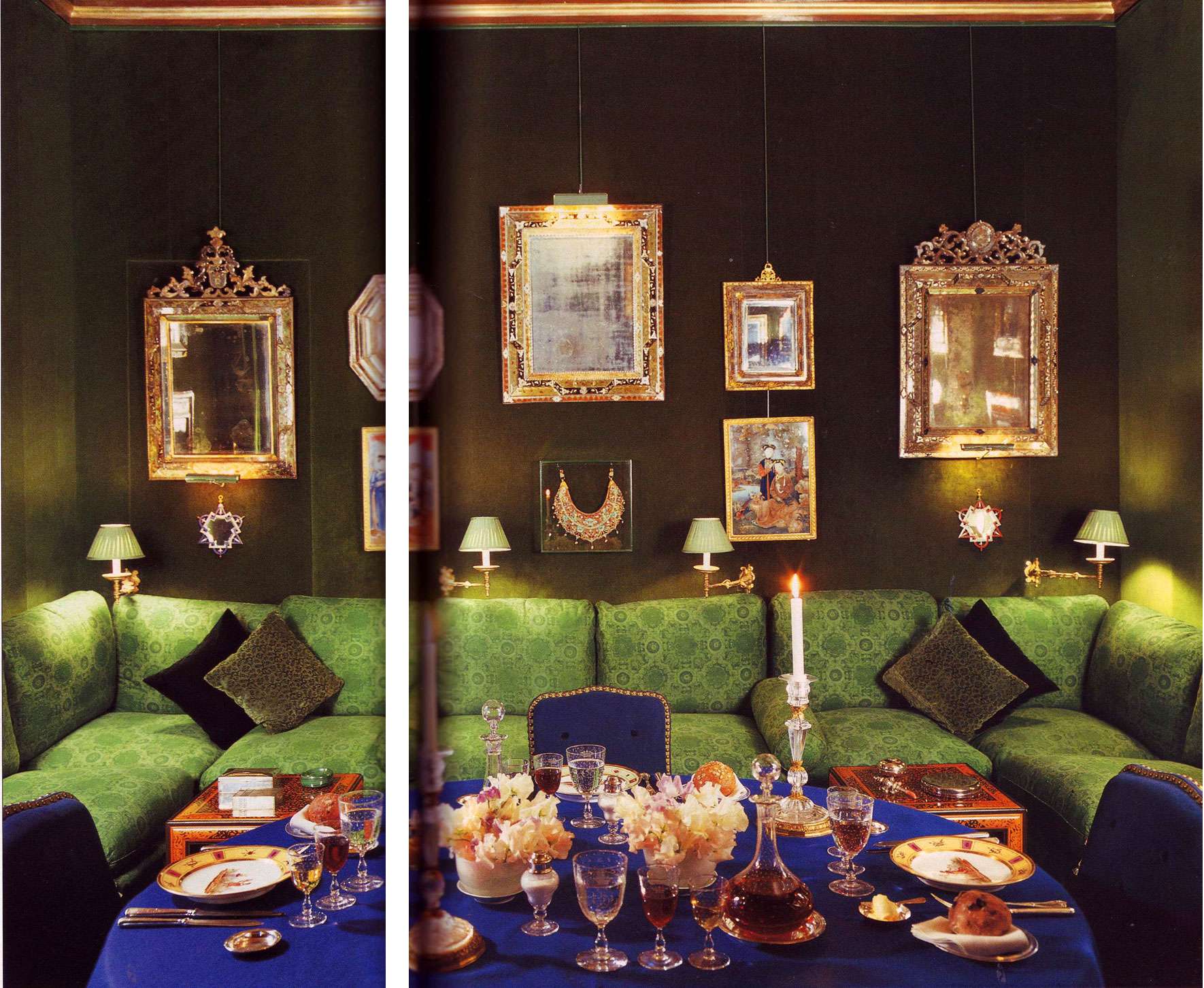Add to the list of things I am reconsidering (rapidly becoming obsessed with): graffiti.
A year ago, I would have called you insane if you had suggested putting this raucous art form in a domestic setting. But seriously, what's wrong with me? Why wouldn't I like it? It's aggressively DIY at its core. And plus, there's something fundamentally compulsive about painting on —embellishing— everything. Is graffiti a contemporary Rococo, a more recent manifestation of that same compulsive decorative impulse?
New York artist Kenny Scharf's Brazilian retreat is covered (and I mean covered, down to the chairs) in graffiti. Admittedly, graffiti in the home is a bizarre concept. While I appreciate his attempt, I have to say that I would do it differently. The fact that the house itself is without electricity and generally lacks in furnishings makes it feel a little too authentically crack shack for me:
This work, by Blek Le Rat (who was trained at the Ecole des Beaux Arts, interestingly enough) is, in contrast, a nice balance of grandeur and decrepitude: the architecture of the building, decrepitude due to age, classical nature of the graffiti figure, and then the underlying element of vandalism that comes as part of the graffiti territory:
Or how about this wallpaper given the graffiti treatment by Australian artist Rok 2? Definitely an innovative way to incorporate this into an interior, I love the way it looks like the wallpaper is chipping away to reveal a weirdly sinister graffiti-dimension beneath it:
I'm interested to know what other people think about this- Y / N to graffiti in a domestic setting? Gaudy mistake or brilliant exercise in contrasting elements?
6.01.2009
Domestic Graffiti?
Labels:
art,
Blek Le Rat,
Graffiti,
graffiti interiors,
Graffiti World,
Kenn Scharf,
Rok 2
5.27.2009
A Day in the Life (of a Stepford Wife?)
According to Amazon, customers who bought a vacuum cleaner also bought:
1. A pillow, filled with gel (??!!!!)
2. A CD: "Just a Little Lovin'"
3. A blender
4. A book: "Passionate Marriage: Keeping Love and Intimacy."
Really? And this is my reaction before I even stopped to consider the concept of a pillow filled with paste.
Dearest Amazon, please tell me you're joking!


1. A pillow, filled with gel (??!!!!)
2. A CD: "Just a Little Lovin'"
3. A blender
4. A book: "Passionate Marriage: Keeping Love and Intimacy."
Really? And this is my reaction before I even stopped to consider the concept of a pillow filled with paste.
Dearest Amazon, please tell me you're joking!


5.19.2009
Gimme an A for Attitude
 Above Left: Ray Johnson Letter to Lucy R. Lippard, 1969, Smithsonian Archives of American Art. Above Right: Ray Johnson collage, artnet.com.
Above Left: Ray Johnson Letter to Lucy R. Lippard, 1969, Smithsonian Archives of American Art. Above Right: Ray Johnson collage, artnet.com."I chose a profile portrait of Andy Warhol. Ray told me the price and foolishly I made him a counteroffer, maybe 80 percent of the price he'd quoted. Ray agreed and said he'd send me the piece in about a week. And of course a week later the Warhol profile arrived in the mail with 20 percent missing from the bottom right corner. I still have the bill here somewhere, charging me for 'most of a Ray Johnson collage.'" -Peter Schuyff, on artist Ray Johnson.
Ray Johnson, I heart you. If you haven't seen How To Draw A Bunny, I highly recommend it. Really interesting, extremely humorous.
XX Lauren
XX Lauren
Labels:
art,
collage art,
How to Draw a Bunny,
people,
pop art,
Ray Johnson
5.18.2009
Tractor Love, Tom Ford, and Hermès Orange, Oh My!
"...this is the guy who had an orange tractor at his property in New Mexico spray-painted black because he couldn't stand the color, okay?" - New York Magazine , on Tom Ford.
One of my favorite little anecdotes. I feel ya Tom, I really do. If I were subjected to this unsightly horror on a daily basis, I would also feel compelled to crack out mass quantities of spray paint and put the construction crew to work doing something useful:

Sometimes, small (large) details make all the difference. Case in point: the '97 Martha incident (you remember, when Martha Stewart tried to run down her neighbor after he erected an 8 foot fence and put in shrubs that "suburbanized" the neighborhood?). I used to have one of these babies (see image below). No joke, I threw it out because the concentrated field of candy corn pumpkin orange was nauseating to me.

Are Tom and I alone in our phobia of this color? Certainly, my sentiment isn't shared by everyone. Take, for instance, the orange tractor fanatics ,who, for sheer viewing pleasure, upload photos of themselves merrily using their orange equipment. (The internet turns up all sorts of gems.)
Of course, you can dismiss our friends over at the orange tractor site as a truly isolated segment of the population, far removed from design concerns of any sort, but then what excuse can you make for people who decorate with Hermès boxes?
Is this a trend or something? Or have boxes replaced books in the world of props that are meant to attest to the cultivated tastes of their owners? If a book (used as a prop) is meant to convey diversity of taste and education, is a logoed box intended to convey taste through association with a brand, or else association with cost? That's almost as vomitous as this color orange.
Developing brand identity is not a replacement for developing taste, kids. And decorating with logo laden cardboard boxes= so not chic. An exception can be made for Andy Warhol's Brillo containers.
Here, I present you with a compulsion to brand oneself at its very worst (see below). Seriously, what's this woman stashing in all of her boxes!? She must have a collection of horse scarves to clothe an army. Either that, or she's bedecked in enough colliers de chien to approximate a couture version of Johnny Rotten. (I sincerely hope it's the latter, in which case, someone send me a picture. Stat.).
5.16.2009
NEVER.
Lately, I've been an avid subscriber to the "never say never" philosophy. This is probably due to the realization that I've embraced (with ZEAL) things that were once solidly in the "never-ever-EVER" category (or so I thought). Take, for instance, shoulder pads. Or fringe. Or cellophane drapes. Or minimalism. Or neon patent. It's gotten to the point where if I hate it, I have to conquer it. The worse it is, the more I want it to work (fanny packs, anyone?).
However, flipping through this gloriously authoritative Doubleday Book of Interior Decorating from 1965, I hesitantly realize that perhaps some things are best left untouched. Forever. For example:
1. Weird greenish brownishwood plastic paneling. Actually, anything that replicates the color of bile. Especially anything synthetic. Please Google image search "bile"— the closeness of the match is truly disquieting.

2. Paris Hilton's bathroom. I jest. But seriously, you know you've taken color coordination too far when you have a MATCHING PINK BIDET.

3. Astroturf is NOT a proper substitute for a rug, no matter what the Doubleday chapter on "Good Taste" insists.

4. Similarly, cheap shower curtains are not functionally or aesthetically equivalent to actual curtains. And industrial nylon carpeting? This is not Loehmann's dressing room, it is a living room. Or so I imagine it was intended.
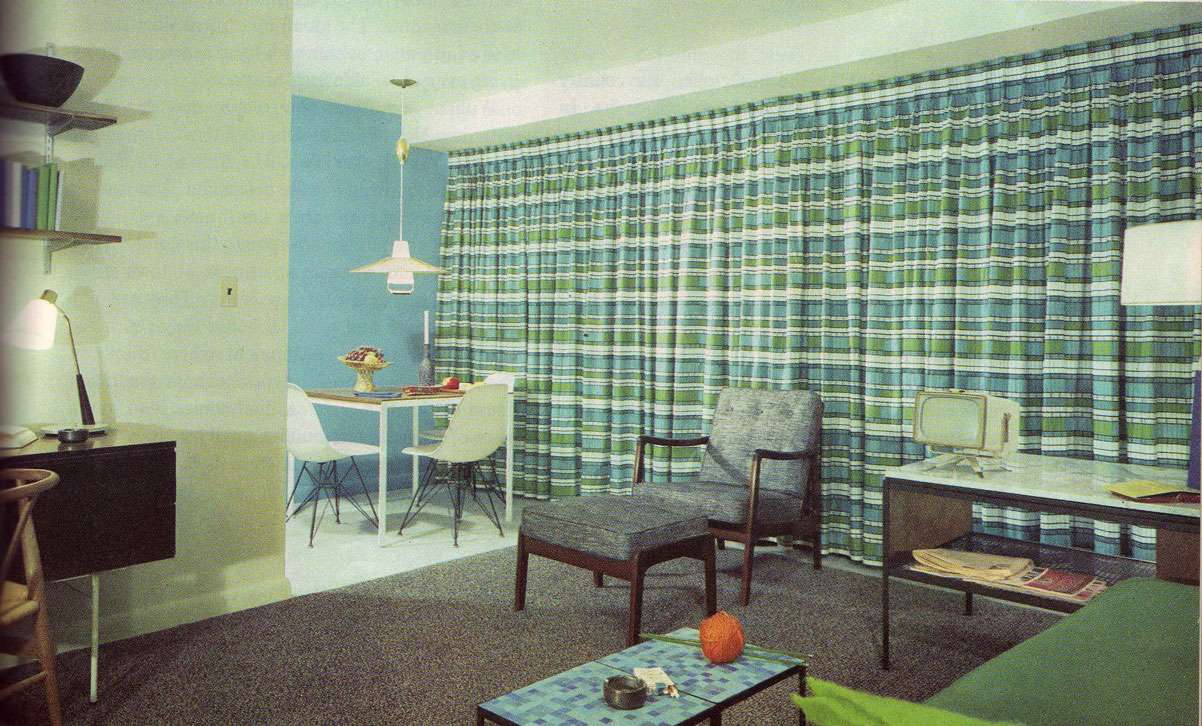
Lesson learned. Sometimes it's okay to say never.
Scans from The Doubleday Book of Interior Decorating by Albert Kornfeld, 1965.
However, flipping through this gloriously authoritative Doubleday Book of Interior Decorating from 1965, I hesitantly realize that perhaps some things are best left untouched. Forever. For example:
1. Weird greenish brownish

2. Paris Hilton's bathroom. I jest. But seriously, you know you've taken color coordination too far when you have a MATCHING PINK BIDET.

3. Astroturf is NOT a proper substitute for a rug, no matter what the Doubleday chapter on "Good Taste" insists.

4. Similarly, cheap shower curtains are not functionally or aesthetically equivalent to actual curtains. And industrial nylon carpeting? This is not Loehmann's dressing room, it is a living room. Or so I imagine it was intended.

Lesson learned. Sometimes it's okay to say never.
Scans from The Doubleday Book of Interior Decorating by Albert Kornfeld, 1965.
5.15.2009
Faucets in Space
Please tell me I'm not the only one who found this market story particularly humorous. Yeah, kitchen hardware in itself doesn't really float my boat, but hey, at least it floats in space, courtesy of The World of Interiors.
Two questions.
1. Why is it that faucets-as-satellites in orbit around Earth are so much more interesting than their silhouetted-against-a-white-background counterparts? Something to consider.
2. What substances were the editors that produced this using? Please inform, I would like some too. And send some over to the U.S. while you're at it. Our shelter mags are in need of it.
Yours truly,
XX Lauren.
Labels:
interiors,
Kitchen faucets,
products,
world of interiors
5.13.2009
Yoes, Yes!
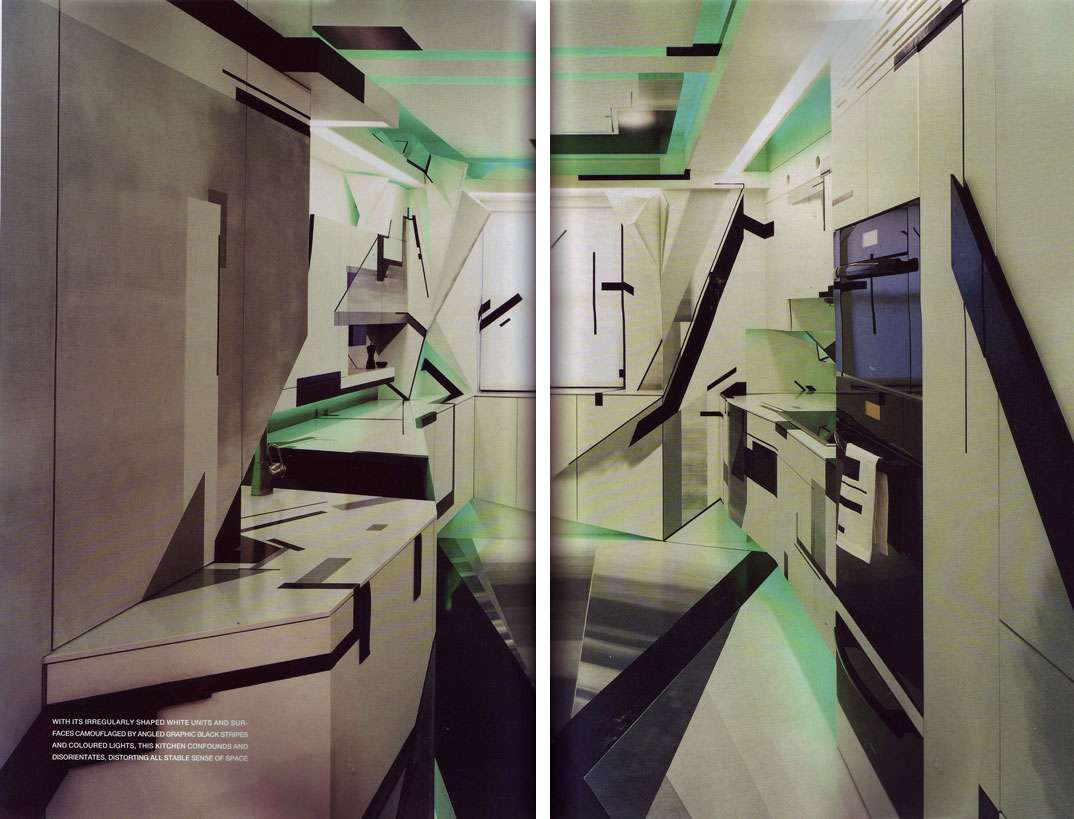 Scan from May 2009 World of Interiors.Photo by Annie Schlechter.
Scan from May 2009 World of Interiors.Photo by Annie Schlechter.One look at this fantastic perspective-bending, spatially disorienting Modernist masterpiece of a kitchen in the April World of Interiors saw me FEVERISHLY Googleing its maker, artist Amy Yoes.
Of course, I wonder how I'd manage to prepare my morning coffee without some degree of vertigo, but then, my love of the space doesn't necessarily stem from my desire to live in it. It does, however, provide comfort to know that there are people who relish taking tea in a work of art!
That having been said, at the crux of my appreciation is Yoes's melding of decorative and structural elements.
The space is ambiguous and confusing: it's not clear what's protruding, what's receding, which surfaces are flat, and which are bent and shattered. And this whole effect is achieved with a combination of structural protrusions and painted blocks and angles, a dialogue between paint, form, and 3d space that ultimately jumbles, shatters, and warps something as functional and common as a kitchen.
Count me impressed.
Of course, I wonder how I'd manage to prepare my morning coffee without some degree of vertigo, but then, my love of the space doesn't necessarily stem from my desire to live in it. It does, however, provide comfort to know that there are people who relish taking tea in a work of art!
That having been said, at the crux of my appreciation is Yoes's melding of decorative and structural elements.
The space is ambiguous and confusing: it's not clear what's protruding, what's receding, which surfaces are flat, and which are bent and shattered. And this whole effect is achieved with a combination of structural protrusions and painted blocks and angles, a dialogue between paint, form, and 3d space that ultimately jumbles, shatters, and warps something as functional and common as a kitchen.
Count me impressed.
5.11.2009
The Gates of Hell
Well, not quite. But these ironwork monstrosities (in the VERY best way, and you know I mean that) are so sublimely beautiful I needed to share. Gothic font, quatrefoils, arches, rococo waves, art nouveau forms, forged ironwork... how I love you. And how interesting is the perspectival illusion of depth in the below right image?!
5.07.2009
Context is KING

"Although these things, heirlooms, portraits, furniture, silver, etc., are in themselves both beautiful and interesting, they seem to me to have a great deal more significance when seen as an integral part of the house. When we see them in their original settings, and against a background in which they were originally used, they mean more; there they seem to tell their whole story, not only of how they were used, but also of the kind of people who created and used them."
-Henry F. du Pont (1880-1969), horticulturist and American decorative arts and furnishings collector, in The Fifty Best Historic American Houses
Couldn't have said it better myself.
Labels:
American art,
art,
decorative art,
H. F. Du Pont,
Henry F. Du Pont,
interiors,
people
5.04.2009
Notes on Color: I Want To Stroke Your Walls
One of the best uses of color that I've ever encountered is at the Fåborg Museum of Art in Denmark. The museum (incidentally, located in the middle of nowhere) left quite an impression on me, indeed.
It wasn't just the neoclassical simplicity of structure combined with the subtleties of color framing, but the texture of the color. I know I've been going on about texture a lot lately (and plaster, too, for that matter...hm), but this color is so rich, so velvety and translucent you just want to TOUCH it. The secret? The walls were painted fresco style! Meaning, the pigment is applied to wet plaster, allowed to dry, and polished after the fact. Check out the cobalt and the subtlety of the pink/gray combination. It seems that these nuances are really what separate amateur from artful in the use of color.

 Fåborg Museum of Art, Denmark. Images from Flickr.
Fåborg Museum of Art, Denmark. Images from Flickr.
As for the use of velvety rich color in an interior , Axel Vervoordt's Venetian palazzo instantly came to mind. His terracotta colored walls seem to have the same matte depth as the museum at Fåborg, and they play well against the deep blue oil by Verheyen and cream slipcovers:
It wasn't just the neoclassical simplicity of structure combined with the subtleties of color framing, but the texture of the color. I know I've been going on about texture a lot lately (and plaster, too, for that matter...hm), but this color is so rich, so velvety and translucent you just want to TOUCH it. The secret? The walls were painted fresco style! Meaning, the pigment is applied to wet plaster, allowed to dry, and polished after the fact. Check out the cobalt and the subtlety of the pink/gray combination. It seems that these nuances are really what separate amateur from artful in the use of color.

 Fåborg Museum of Art, Denmark. Images from Flickr.
Fåborg Museum of Art, Denmark. Images from Flickr.As for the use of velvety rich color in an interior , Axel Vervoordt's Venetian palazzo instantly came to mind. His terracotta colored walls seem to have the same matte depth as the museum at Fåborg, and they play well against the deep blue oil by Verheyen and cream slipcovers:
Labels:
Architectural Digest,
art,
Axel Vervoordt,
colors,
Danish Art,
Faaborg Museum,
Fåborg Museum,
frescos,
interiors,
primary color,
Venetian palazzo
4.30.2009
The Freshest Fragrance
 Sometimes, all it takes is a bouquet of fresh flowers to make you realize how deficient even the most expensive perfumes are at making a room smell heavenly.
Sometimes, all it takes is a bouquet of fresh flowers to make you realize how deficient even the most expensive perfumes are at making a room smell heavenly. It occurs to me that magazines frequently run stories on the best home fragrances— in the form of sprays, oils, atomizers, candles, diffusers, potpourri, incense, you name it. And frankly, most of them are god awful. Someone needs to do a story on the various fresh flowers that can be used to fragrance a room. Stat.
I write this because I currently have a pot of Oriental lilies sitting on my desk and I'm fully convinced I have a new favorite flower. So convinced, that even though I'm quite aware a photograph can't convey scent of any sort, I still felt compelled to shoot them.
I'd describe the aroma as really thick and sweet, sort of smoky or woody even. It's soft, but it definitely permeates the room. Makes me swoon every time I inhale, actually.
Labels:
flowers,
home fragrance,
interiors,
my interiors,
oriental lilies
4.29.2009
Forcola Forms
I've always felt that the only thing more gratifying than discovering a beautiful objet d'art is appropriating one from an unexpected context.
Take, for instance, the forcola. These are pretty much a perfect example of what I'm talking about: Hand carved, sinuously graceful forms that are actually designed to hold the oar on a Venetian gondola! In any case, one — or even better — a collection en masse, would make an interesting addition to a vignette. Almost better than a collection of obelisks, even.
I think it's the solid architectural quality that appeals to me most. Actually, I think I may have read somewhere that the architect I.M. Pei was similarly captivated by their form, but don't quote me...
As for my shot of the gondola factory, well... just chalk it up to being in a Venetian mood. And seriously, if anyone is planning a trip to Venice anytime soon (jealous!), there's an amazing cicheti place right across the canal, in Dorsoduro. Mmm... I think I need a vacation.
Take, for instance, the forcola. These are pretty much a perfect example of what I'm talking about: Hand carved, sinuously graceful forms that are actually designed to hold the oar on a Venetian gondola! In any case, one — or even better — a collection en masse, would make an interesting addition to a vignette. Almost better than a collection of obelisks, even.
I think it's the solid architectural quality that appeals to me most. Actually, I think I may have read somewhere that the architect I.M. Pei was similarly captivated by their form, but don't quote me...
As for my shot of the gondola factory, well... just chalk it up to being in a Venetian mood. And seriously, if anyone is planning a trip to Venice anytime soon (jealous!), there's an amazing cicheti place right across the canal, in Dorsoduro. Mmm... I think I need a vacation.
Labels:
art,
forcola,
forcole,
gondolas,
objet d'art,
sculptural forms,
Venice
4.27.2009
The (Not So) Sexy Seventies
One of life's simplest joys is perusing womens' mags from bygone (read: antiquated) eras. Take, for instance, this delightful Cosmo fr0m the 70s.
My question is this: How did people survive 1978?! Where, oh where, do I begin?
I mentioned yesterday that decor from the 70s often looks extraordinarily dated. Case in point follows. Not even in my wildest dreams could I imagine, however, thehorror apex of perfection that results when you add in a matronly lady wearing more lace than Queen Elizabeth, seducing a splayed-leg archetypal porn-star plummer. I mean, seriously, are we to believe that our lady friend has just rolled out of bed in her polyester jammies with intentions of perfecting a new painting technique that involves holding her brush like an, uh, bat, and sucking on it? This is questionable.

Moving right along, Richard Simmons doles out advice on "spending a healthy weekend with your mate." Perhaps the couple above took his advice to heart, sort of like the couple rollerskating in tube socks (but somehow, the poor things have forgotten their pants!) below. I didn't know that Richard Simmons (sans afro, below) produced stories for Cosmo. No, really. This isn't a joke. Richard Simmons is actually credited as the producer.

And hey, if healthy living isn't your thing, take tips from the stars on staying svelte in "How to Stay Thin," (or, "How to Develop an Eating Disorder"). The real cherry on the cake is Geraldine Chaplin: "I tell myself food is horrible...or I think of all the romantic heroines who died of consumption." Say WHAT? Did our dear Geraldine actually believe that the heroines ate themselves to death?!! This is a frightening image. Someone, inform the girl that consumption=tuberculosis! On another note, I wonder if Babs is still avoiding cholesterol.
My question is this: How did people survive 1978?! Where, oh where, do I begin?
I mentioned yesterday that decor from the 70s often looks extraordinarily dated. Case in point follows. Not even in my wildest dreams could I imagine, however, the

Moving right along, Richard Simmons doles out advice on "spending a healthy weekend with your mate." Perhaps the couple above took his advice to heart, sort of like the couple rollerskating in tube socks (but somehow, the poor things have forgotten their pants!) below. I didn't know that Richard Simmons (sans afro, below) produced stories for Cosmo. No, really. This isn't a joke. Richard Simmons is actually credited as the producer.

And hey, if healthy living isn't your thing, take tips from the stars on staying svelte in "How to Stay Thin," (or, "How to Develop an Eating Disorder"). The real cherry on the cake is Geraldine Chaplin: "I tell myself food is horrible...or I think of all the romantic heroines who died of consumption." Say WHAT? Did our dear Geraldine actually believe that the heroines ate themselves to death?!! This is a frightening image. Someone, inform the girl that consumption=tuberculosis! On another note, I wonder if Babs is still avoiding cholesterol.
Labels:
70s,
bad design,
Cosmo,
Cosmopolitan Magazine,
fashion,
interiors,
seventies
4.26.2009
I Like My Neutral Well-Done
Feeding my growing fascination with texture, white on white and beige color palettes, and weirdly fantastical design elements, I stumbled upon the work of John Dickinson (1920-82), a San Francisco based designer who was popular in the 60s and 70s. Funny how work from this era is so prone to looking dated, yet this work looks just as fresh now as it must have then.
Every month, there's a certain subset of design mags that inevitably run stories on neutral color schemes. You know the drill: "Neutrals are anything but boring!" "Neutrals are the new trend!" "Neutrals you can live with!" Etc. etc. etc.
I love neutrals as much as the next person but there's such an abundance of really generic, uninspired design in this arena that it's easy to forget how great a room can look when someone who really understands color and tactility puts it together. And this is precisely why I was captivated by his work!
His own residence in San Francisco is hitting all the right notes for me right now. Apparently, it was one of the most heavily photographed interiors in its day. Textured walls, subtle play of warm creams and ochres, complete with the density and dryness of his plaster heads and furnishings contrasting against the shiny surfaces... it's heavenly. Now THIS is a neutral well done:

As you might know, I've been feeling (this is an extreme understatement) white on white vignettes as of late. I've been contemplating doing my own involving ostrich eggs for some time. Seeing this image on the left has confirmed that desire. Can you tell that Dickinson worked in window display before becoming a decorator? And that building facade on the right ? Oh, that's a carved wood closet. Is your jaw dropping yet?
Finally, two of Dickinson's plaster tables. The dense chalky plaster and mottled slightly warm color make all the difference when pulling off a design that's more, uh, "out there.," like say, for instance, a hoofed table. I remember reading a quote somewhere that it's much easier to pull off avant-garde shapes and proportions when color is kept to a minimum. Of course, it was in reference to clothing, but you know, I think the same holds true for interiors.
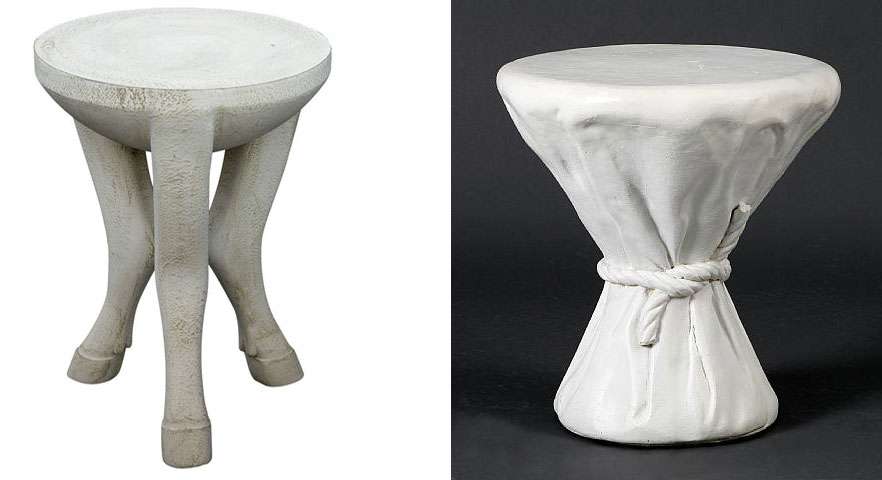
For those interested, there are a few of Dickinson's pieces up on 1st Dibs at the moment, including one of his famous footed plaster tables (asking price is $35,000.00). Anyone interested in buying me an early birthday gift? Ahh, if only.
Every month, there's a certain subset of design mags that inevitably run stories on neutral color schemes. You know the drill: "Neutrals are anything but boring!" "Neutrals are the new trend!" "Neutrals you can live with!" Etc. etc. etc.
I love neutrals as much as the next person but there's such an abundance of really generic, uninspired design in this arena that it's easy to forget how great a room can look when someone who really understands color and tactility puts it together. And this is precisely why I was captivated by his work!
His own residence in San Francisco is hitting all the right notes for me right now. Apparently, it was one of the most heavily photographed interiors in its day. Textured walls, subtle play of warm creams and ochres, complete with the density and dryness of his plaster heads and furnishings contrasting against the shiny surfaces... it's heavenly. Now THIS is a neutral well done:

As you might know, I've been feeling (this is an extreme understatement) white on white vignettes as of late. I've been contemplating doing my own involving ostrich eggs for some time. Seeing this image on the left has confirmed that desire. Can you tell that Dickinson worked in window display before becoming a decorator? And that building facade on the right ? Oh, that's a carved wood closet. Is your jaw dropping yet?
Finally, two of Dickinson's plaster tables. The dense chalky plaster and mottled slightly warm color make all the difference when pulling off a design that's more, uh, "out there.," like say, for instance, a hoofed table. I remember reading a quote somewhere that it's much easier to pull off avant-garde shapes and proportions when color is kept to a minimum. Of course, it was in reference to clothing, but you know, I think the same holds true for interiors.

For those interested, there are a few of Dickinson's pieces up on 1st Dibs at the moment, including one of his famous footed plaster tables (asking price is $35,000.00). Anyone interested in buying me an early birthday gift? Ahh, if only.
Labels:
art,
interiors,
John Dickinson,
neutral color scheme,
neutrals,
people,
surreal design
4.23.2009
Lick These Windows
The French translation of "window shopping" is "lèche vitrine," which, incidentally, literally means "window licking." I've always thought this was a little bizarre, but sometimes, I can see where they're coming from.
There are few things more inspirational than a well done window display. A beautiful window is like an engaging, voyeuristic snippet for the gossipy Betty in all of us— a 3-D interpretation of surrealism, a fabulous dramatic set without the boring play. Inventive use of materials? Check. Bizarro nightmarish hellbeasts? Check. Gorgeous Clothes? Of course! Something about the medium just lends itself to so much more inventiveness than most people would ever tolerate in an interior.
1. If it weren't a long gone holiday window, I would consider moving into this texture filled white-on-white fantasy for Bergdorf Goodman, under the direction of Linda Fargo.
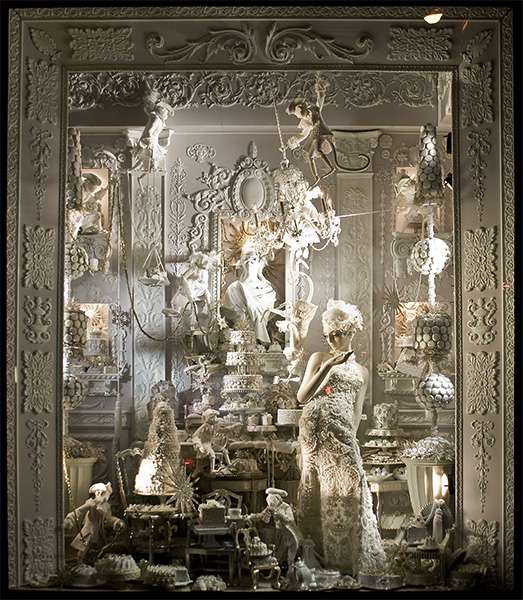 Photo by Rudy Pospisil, anothernormal.com
Photo by Rudy Pospisil, anothernormal.com
 Photo by Rudy Pospisil, anothernormal.com
Photo by Rudy Pospisil, anothernormal.com
3. Windows for Barneys, under the direction of Simon Doonan. The way that Doonan incorporates the most unconventional objects (read: trash) into his creations always amazes me.
4. Windows for Barneys, under the direction of Simon Doonan.
5. Windows for Barneys, under the direction of Simon Doonan.
There are few things more inspirational than a well done window display. A beautiful window is like an engaging, voyeuristic snippet for the gossipy Betty in all of us— a 3-D interpretation of surrealism, a fabulous dramatic set without the boring play. Inventive use of materials? Check. Bizarro nightmarish hellbeasts? Check. Gorgeous Clothes? Of course! Something about the medium just lends itself to so much more inventiveness than most people would ever tolerate in an interior.
1. If it weren't a long gone holiday window, I would consider moving into this texture filled white-on-white fantasy for Bergdorf Goodman, under the direction of Linda Fargo.
 Photo by Rudy Pospisil, anothernormal.com
Photo by Rudy Pospisil, anothernormal.com2. Another holiday window from Bergdorf Goodman, under the direction of Linda Fargo.
 Photo by Rudy Pospisil, anothernormal.com
Photo by Rudy Pospisil, anothernormal.com3. Windows for Barneys, under the direction of Simon Doonan. The way that Doonan incorporates the most unconventional objects (read: trash) into his creations always amazes me.
5. Windows for Barneys, under the direction of Simon Doonan.
Labels:
art,
barneys window displays,
Barneys windows,
bergdorf goodman holiday windows,
bergdorf goodman window displays,
fashion,
linda fargo,
simon doonan,
window display
4.21.2009
Indecorous Cake
Am I the only one addicted to that Food Network show "Challenge" where contestants furiously concoct sugary sculptures 3 foot plus in height? As if these wouldn't stand on their own as centerpieces, it's made so much better by the fact that the medium is...cake.
I wonder what happens when the show is over. People can't actually eat the centerpieces. Can they?
I wonder what happens when the show is over. People can't actually eat the centerpieces. Can they?
Labels:
Cake Decoration,
food,
Food Network Challenge,
misc,
parties
4.14.2009
You Are What You Read
 Well, maybe not. But at the very least, your design aesthetic is informed by what you read and look at; of this, I am convinced.
Well, maybe not. But at the very least, your design aesthetic is informed by what you read and look at; of this, I am convinced.For that reason, I've always loved looking at the books that are used as props in shoots. It's sort of one of those guiltily satisfying games, you know? Books on display in rooms are funny things: either someone reads them and loves them, or wants you to think that they read them and love them. Involve stylists, decorators, proud homeowners and magazines with international readerships, and well, what you get is a fantastic game of artifice!
That having been said, these are a few of my (genuine) favorites at the moment (clockwise from top left.) As a side note, any of these would make fab gifts for the design minded and creatively inclined:
1. Artists' Houses by Gerard-Georges Lemaire, Jean-Claude Amiel. The lives and personal spaces of creative and eccentric people are a source of never ending interest to me. This book has all of the standards (Church, William Morris) and impressively, some more bizarre finds.
2. Faberge and the Russian Master Goldsmiths, by Gerard Hill, G.G. Smorodinova, B.L. Ulyanova. Gorgeous, glossy images of the famous eggs, jewelry, and other objets d'art. We've all seen the eggs—in my opinion its the copious images of snuff boxes, jewelry, and imperial gifts that make this book really worthwhile.
3. Inside the White Cube: The Ideology of the Gallery Space by Brian O'Doherty and Thomas McEvilley. A really thought provoking look at the confines of the "white box" gallery and the ways in which artists have reacted to it. This one always makes me think about context, and how I choose to display art.
4. Vogue Living: Houses Gardens People by Hamish Bowles. This hefty volume has gotten a lot of hype, but in my opinion, it's well deserved. Of course, glossy images of interiors are always more interesting when there's a character involved, and there's a whole lot of character in here— everyone from Madonna to Julian Schnabel, and plenty in between.
5. Beds by Diane Von Furstenberg. Beds are an intimate window into their owner's lives, and good old Diane has assembled quite an impressive collection of some of the finest bedrooms around.
6. Dictator Style by Peter York and Douglas Coupland. This one is all in good fun. The tone is casual, but the writing leaves a lot to be desired. Some of the images are surprisingly posh, some are riotously hilarious.
7. Tony Duquette by Wendy Goodman, Hutton Wilkinson and Dominick Dunne. The images in here are literally like dreams. Think fantastical sets, elaborate costume balls, and creative, over the top interiors.
8. Confessions of a Window Dresser: Tales from the Life of Fashion by Simon Doonan. The bizarrely cool creative director from Barney's shares stories of eccentricity and comedy, alongside images of imaginative and surreal window displays. What's not to love?
9. Interiors by Minn Hogg, Wendy Harrop and the World of Interiors. Some of the best interiors you'll ever encounter, divided into several decorating "categories". I go back to this time and again. Enough said.
10. The Hermitage: The History of The Buildings and Halls ed. by Nina Grishina and Maria Lyzhenkova. Bar none, my favorite museum is the Hermitage. The way one views art here makes it worth the trip to Russia alone. This book is about the building itself, rather than the artwork hanging on the walls. Take note of the richly textured finishes and luscious use of color.
Labels:
art,
art books,
artists homes,
artists' interiors,
beds,
best design books,
Dictator style,
Faberge,
gallery aesthetic,
hermitage,
interiors,
products,
simon doonan,
tony duquette,
vogue living
4.12.2009
Green (and red, and blue, and white) Eggs and Ham
When we were kids, my mom enrolled my brother and I in a mini course that taught the art of dying Pysanky— Ukranian easter eggs. Two things: 1. We're not of Ukranian descent. 2. We were never raised with religion. But who cares? Pysanky is quite beautiful and the process by which it's created is interesting and involved.
Of course, we made the eggs when we were young and they're not refined like ones made by professional artisans, but there's still something redeeming about them.
On another note, I'm kind of obsessed with the architectural quality of clean, blown ostrich eggs. If you didn't know better, you might think they're porcelain. Currently contemplating amassing a ton for a little vignette or something. We'll see.

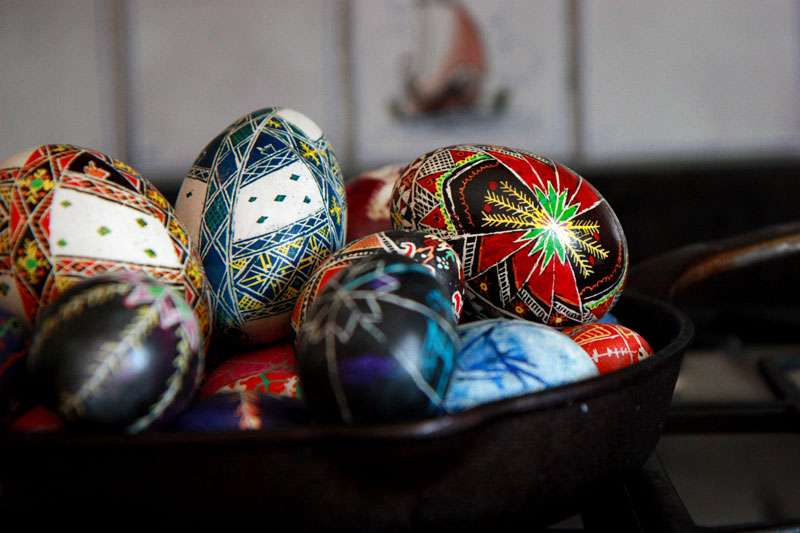
Of course, we made the eggs when we were young and they're not refined like ones made by professional artisans, but there's still something redeeming about them.
On another note, I'm kind of obsessed with the architectural quality of clean, blown ostrich eggs. If you didn't know better, you might think they're porcelain. Currently contemplating amassing a ton for a little vignette or something. We'll see.


4.11.2009
Dinner Craze, Part 2
I love pre-spring dinner parties. Feeling obsessed inspired by the last dining room I posted, I whipped up my own version. These first two images look so fresh and cheery; it's funny how nighttime, reflective surfaces, candlelight, and a trashy 80s gem-encrusted number can completely change the ambiance. Or maybe that was just the wine I polished off while cooking dinner... cheers!






Labels:
entertaining,
interiors,
my interiors,
parties
4.07.2009
Inside, Outside-In Dining
I've been thinking a lot about outdoor dining lately. Too bad it's cold enough for me to be wearing two sweaters.
While pondering having guests wear gloves and parkas to dinner, I remembered this gorgeous image and promptly recovered from my delusions:
How lush is that?! Copious potted plants create a fantastic wall of greenery, minus the pesky bugs I'm surely going to be complaining about when I do finally have my dinner outdoors. It also doesn't hurt that the Chinese lanterns and soft light remind me of John Singer Sargent's "Carnation Lily Lily Rose." Actually, that's a pretty great source of inspiration for an elegant springtime dinner; I wonder if Kime had it in mind when he designed his conservatory dining room...
While pondering having guests wear gloves and parkas to dinner, I remembered this gorgeous image and promptly recovered from my delusions:
How lush is that?! Copious potted plants create a fantastic wall of greenery, minus the pesky bugs I'm surely going to be complaining about when I do finally have my dinner outdoors. It also doesn't hurt that the Chinese lanterns and soft light remind me of John Singer Sargent's "Carnation Lily Lily Rose." Actually, that's a pretty great source of inspiration for an elegant springtime dinner; I wonder if Kime had it in mind when he designed his conservatory dining room...
4.04.2009
Wall of Mirrors
Soft lights reflected in hazy antique mirrors radiate a seductive beauty that can only be described as sexy. So, boys, take note: Forgo the disco ball, cheepo satin sheets and cheesy pickup lines, and go get yourself some old mirrors and candles instead.
In all seriousness though, I'm all over this look. For a fresh interpretation, you might assemble a mosaic with panels of antique mirrors:
Or you could try a more traditional approach and arrange framed mirrors on a wall alongside paintings:
In all seriousness though, I'm all over this look. For a fresh interpretation, you might assemble a mosaic with panels of antique mirrors:
Or you could try a more traditional approach and arrange framed mirrors on a wall alongside paintings:
Labels:
interiors,
mirrors,
sexy rooms,
soft lighting,
wall of mirrors
4.03.2009
A Peek...
Some people make impulse purchases of things like magazines and chewing gum. A rainy day antiquing session led to my purchasing a new bed.
So, the checking account will hurt for a little while. But what can you do when love strikes? I remember once reading an article suggesting that one should only buy furniture out of love, never necessity. The author spoke of being young and abroad and falling for a coffee table that she could barely afford and for which she didn't have the space. She credited this experience for changing her outlook on buying furniture; while her interior changed countless times over the years, it was never without her beloved pieces.
The idea is that if you buy only decor you fall in love with, your interior will take more time to construct, but you'll never grow tired of it, as you'll always find a place for those pieces that speak to you. I adore the interiors of collectors' for this very reason.
As soon as the weather clears up, I'll foray into the world of the French polish. Until then, I leave you with a peak of things to come:


So, the checking account will hurt for a little while. But what can you do when love strikes? I remember once reading an article suggesting that one should only buy furniture out of love, never necessity. The author spoke of being young and abroad and falling for a coffee table that she could barely afford and for which she didn't have the space. She credited this experience for changing her outlook on buying furniture; while her interior changed countless times over the years, it was never without her beloved pieces.
The idea is that if you buy only decor you fall in love with, your interior will take more time to construct, but you'll never grow tired of it, as you'll always find a place for those pieces that speak to you. I adore the interiors of collectors' for this very reason.
As soon as the weather clears up, I'll foray into the world of the French polish. Until then, I leave you with a peak of things to come:


Labels:
antique bed,
cuban feather mahogany,
interiors,
maison archinard,
my interiors,
my projects,
ormolus
Subscribe to:
Posts (Atom)

